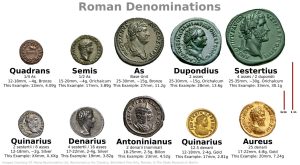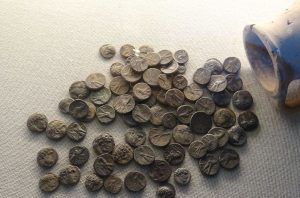If you have ever traveled to a foreign country or even received cash from another country, you have been to a money changer. Usually these are rather modest set ups – a small entrance and place for the customer, the money changer behind a glass divider with an opening to place your cash and receive local currency in return. The counter/table is a feature that is always present because how else would you be able to hand over the money in an orderly fashion? This table is what lends its name to the money changer, as we see in the Mishnah here:
מַתְנִי׳ הַמַּפְקִיד מָעוֹת אֵצֶל שׁוּלְחָנִי
MISHNA: one who deposits money with a money changer (Bava Metzia 43a)

Jewish money changer in Israel 1934
Matson Collection, Public domain, via Wikimedia Commons
The Hebrew for money changer is shulhani, literally table guy. This word is rarely used in modern Hebrew; we use the more prosaic חלפן (chalfan) which means someone who exchanges things. But the original word is more interesting because it paints a picture of the money changer at his station. The word shulhani is a literal translation of the Greek trapezite, coming form the word trapeze, a table. That word is a shortening of tetrapez, a combination of the Greek words four (tetra) and foot or edge (peza) – a four-legged table. (And for those people excited about words and mathematics, it is also the origin of the geometric form trapezoid.)
A shulhan is a generic word for table in Hebrew, the rabbis had other words as well that denoted different types of table surfaces: tavla, dalpak. Dr. Keren Kirschenbaum in her book about furniture in the time of the Mishnah explains that a shulhan could also mean a foldable table – a counter that hangs on the wall and can be lowered onto legs when needed. This would be appropriate for a money changer who has to set up shop but might not have a lot of space. Kirschenbaum brings the following Mishnah to explain this:
“A money changer’s nail (מסמר של שולחני) is clean, But Rabbi Zadok says: it is susceptible to impurity.” (Keilim 12:5)
While Maimonides thought that the nail in question is to hang up the money changer’s scales, others explain that it is the piece that attaches the counter to the base when the table of folded down and in use.
What was the function of the money changer? Besides the obvious – giving local currency in exchange for foreign currency – the job entailed a few other responsibilities. One was making change, i.e., giving a large coin in return for smaller ones and vice versa. We see this in the Mishnah in Masser Sheni:
“Maaser sheni may be redeemed at the lower market price: . . At the price at which the money changer takes small change and not at the price at which he gives small change.” (Maaser Sheni 4:2)

Trombonist04, CC BY-SA 4.0 <https://creativecommons.org/licenses/by-sa/4.0>, via Wikimedia Commons
A money changer could also function as a bank where you could store your money. This is what our Mishnah is discussing and like a bank today, the assumption is that the money changer could use your money, as long as in the end you receive money (not necessarily yours) in return:
“if the money is bound, the money changer may not use it. Therefore, if it is lost he does not bear responsibility for it. If the money was unbound, the money changer may use it. Therefore, if it is lost he bears responsibility for it.” (Bava Metzia 43a)
Another important job of the money changer was transferring payment. He was the Venmo or Paybox of the day, as we see in this Mishna:
“If the one who owes the money transferred his payment by leaving instructions with a storekeeper or with a money changer to pay him” (Bava Metzia 9:12)
The Greeks and Romans, and through cultural assimilation, the Jews, had a rather sophisticated financial system that predated the economic tools we use today. But the Jews gave another task to the shulhani – the job of collecting money for the Temple, itself a wealthy bank:
“On the fifteenth of Adar, [money changers would] sit at tables set up in the rest of the country. On the twenty-fifth of Adar, the money changers sat in the Temple.” (Shekalim 1:1)
The half-shekel tax to the Temple was an annual obligation and it allowed all Jews to participate in Temple worship even if they were unable to make the pilgrimage to Jerusalem (see https://hadran.org.il/author-post/pilgrims-progress/). But to pay that tax you needed a special coin, the Tyrian shekel. The shulhani would not only collect and then send the money to the Temple, he would also exchange the smaller and/or local coins for the specific coin that was acceptable for the tax. In return for his labors, he received a surcharge fee, known as the kolbon, which equaled between 4-8% of the value of the half shekel.

Coin hoard discovered at Usafiya in the Carmel, containing many Tyrian shekels and half shekels
Hanay, CC BY-SA 3.0 <https://creativecommons.org/licenses/by-sa/3.0>, via Wikimedia Commons
The Temple was a repository for enormous sums of money. Despite stringent rules against taking advantage of Temple treasures (meilah) in the last decades of the Second Temple’s existence we know that there was much corruption among some of the priests (see https://hadran.org.il/author-post/a-date-with-destiny/). We have many criticisms in the Gemara of certain priests who took advantage of the opportunities to accrue wealth through the Temple. The New Testament also records an incident where Jesus is incensed at the connection between money and the Temple:
“Jesus entered the temple courts and drove out all who were buying and selling there. He overturned the tables of the money changers and the benches of those selling doves. “It is written,” he said to them, “‘My house will be called a house of prayer,’ but you are making it ‘a den of robbers.’” (Matthew 21:12-13)
Jesus’ rage was either misdirected or misunderstood. Corruption is wrong and the rabbis fought against it by instituting many laws against meilah. But commerce in the areas near the Temple was essential. Jews needed (and wanted) to take part in the business of the sacrifices. Judaism always tries to elevate the material world through spirituality, rather than getting rid of materialism altogether. The moneychangers were part of that transfer, enabling worshippers to connect to God even when they could not get to Jerusalem.
Moneychangers were not only sources of cash but of knowledge, the financial advisors of the day. They knew which coins were valuable and which were worthless and what you could get for your money. This element of the moneychanger’s expertise is powerfully expressed by Rabbi Akiva in mourning his great teacher Rabbi Eliezer ben Hyrcanus. In his eulogy for him, he began with this:
“’My father, my father, the chariot of Israel and its horsemen’ (II Kings 2:12). I have many coins, but I do not have a money changer to whom to give them,” (Sanhedrin 68a)
The Maharsha (Rabbi Shmuel Eidels, 16th century Poland) explains that Rabbi Akiva possessed much Torah knowledge (“coins”) but without the wisdom of his teacher he could not use this knowledge to its greatest extent. He needs Rabbi Eliezer, his shulhani, to truly use his Torah in the best way.










